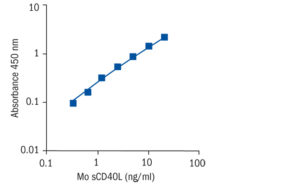sCD40L Mouse ELISA
CD40 belongs to the TNF receptor superfamily. While the biological role of some of the ligand-receptor pairs in this family still remains obscure, CD40 has proven its importance. A key role of CD40/CD40 ligand interactions in immune activation, particularly in T-cell dependent B cell responses is anticipated. This molecule as well as the other ligands of the family share the property of co-stimulation of T-cell proliferation and are all expressed by activated T-cells.
The programmed cell death has been suggested to be involved in clonal elimination of self-reactive lymphocytes for the normal function of the immune system. Interaction with membrane bound self antigens may eliminate self-reactive nature B cells by apoptosis. Antigen-receptor mediated B cell apoptosis is blocked when a signal is transduced via the CD40 molecule on the B cell surface.
Because the ligand of CD40 (CD40L) is expressed on activated T helper cells, B cells may escape from apoptosis and are activated when the immune system interacts with foreign antigens, which are normally able to activate T-helper cells. Thus the CD40 – CD40L interaction plays a central role in the various phases of the B cell response to T-dependent antigens.
Taken together, B cells can participate in regulating their own destruction. Protection against Fas-dependent apoptosis afforded by immunoglobulin-receptor engagement may constitute a fail-safe mechanism that eliminates bystander B cells activated by CD40L – expressing T cells, but ensures survival of antigen-specific B cells.
CD40 Ligand is expressed on the surface of activated CD4+ T cells, basophils, and mast cells. Binding of CD40L to its receptor, CD40, on the surface of B cells stimulates B-cell proliferation, adhesion and differentiation. A soluble isoform of CD40L has been shown to exist in the circulation. This soluble molecule is a homotrimer of a 18kDa protein exhibiting full activity in B cell proliferation and differentiation assays, is able to rescue B cells from apoptosis and binds soluble CD40.
Type
Sandwich ELISA, HRP-labelled antibody
Applications
Serum, Cell culture supernatant
Sample Requirements
50 µl/well
Storage/Expiration
Store the complete kit at 2–8°C. Under these conditions, the kit is stable until the expiration date (see label on the box).
Calibration Curve

Calibration Range
0.31–20 ng/ml
Limit of Detection
0.14 ng/ml
Intra-assay (Within-Run)
CV = 6.5%
Inter-assay (Run-to-Run)
CV = 11.1%
Spiking Recovery
85,00%
Dilutation Linearity
96,00%
– Cosman D. A family of ligands for the TNF receptor superfamily. Stem Cells. 1994 Sep;12 (5):440-55
– Durie FH, Fava RA, Foy TM, Aruffo A, Ledbetter JA, Noelle RJ. Prevention of collagen-induced arthritis with an antibody to gp39, the ligand for CD40. Science. 1993 Sep 3;261 (5126):1328-30
– Lane P, Brocker T, Hubele S, Padovan E, Lanzavecchia A, McConnell F. Soluble CD40 ligand can replace the normal T cell-derived CD40 ligand signal to B cells in T cell-dependent activation. J Exp Med. 1993 Apr 1;177 (4):1209-13
– Rathmell JC, Townsend SE, Xu JC, Flavell RA, Goodnow CC. Expansion or elimination of B cells in vivo: dual roles for CD40- and Fas (CD95)-ligands modulated by the B cell antigen receptor. Cell. 1996 Oct 18;87 (2):319-29
– Rothstein TL, Wang JK, Panka DJ, Foote LC, Wang Z, Stanger B, Cui H, Ju ST, Marshak-Rothstein A. Protection against Fas-dependent Th1-mediated apoptosis by antigen receptor engagement in B cells. Nature. 1995 Mar 9;374 (6518):163-5
– Tsubata T, Murakami M, Nisitani S, Honjo T. Molecular mechanisms for B lymphocyte selection: induction and regulation of antigen-receptor-mediated apoptosis of mature B cells in normal mice and their defect in autoimmunity-prone mice. Philos Trans R Soc Lond B Biol. 1994 Aug 30;345 (1313):297-301

